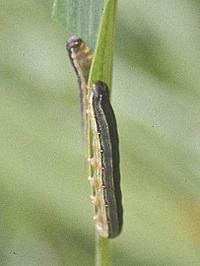
Structure-function analysis of PGRP-S1 from the oriental armyworm, Mythimna separata.
Sign Up to like & getrecommendations! Published in 2021 at "Archives of insect biochemistry and physiology"
DOI: 10.1002/arch.21763
Abstract: Peptidoglycan recognition proteins (PGRPs) are well known for their abilities to recognize or hydrolyze peptidoglycan (PGN), one of the major bacterial cell wall components. However, much less is known about their antifungal activities. PGRP-S1 was… read more here.
Keywords: pgrp; analysis; mythimna separata; microscopy ... See more keywords

Characterization and functional analysis of a β-adrenergic-like octopamine receptor from the oriental armyworm (Mythimna separata Walker).
Sign Up to like & getrecommendations! Published in 2021 at "Archives of insect biochemistry and physiology"
DOI: 10.1002/arch.21772
Abstract: The β-adrenergic-like octopamine receptor (OA2B2), which binds the biogenic amine octopamine, belongs to the class of G-protein coupled receptors and significantly regulates many physiological and behavioral processes in insects. In this study, the putative open… read more here.
Keywords: mythimna separata; adrenergic like; analysis; octopamine receptor ... See more keywords

RNA-Seq identification of candidate defense genes by analyzing Mythimna separata feeding-damage induced systemic resistance in Balsas teosinte.
Sign Up to like & getrecommendations! Published in 2019 at "Pest management science"
DOI: 10.1002/ps.5519
Abstract: BACKGROUND Armyworm (Mythimna separata) is a destructive herbivore for maize. Balsas teosinte (Zea mays ssp. parviglumis), the direct wild ancestor of cultivated maize, has shown great potential to defend against herbivory. Here, based on armyworm… read more here.
Keywords: mythimna separata; defense; armyworm attack; resistance ... See more keywords

The Mythimna separata general odorant binding protein 2 (MsepGOBP2) is involved in the larval detection of the sex pheromone (Z)-11-hexadecenal.
Sign Up to like & getrecommendations! Published in 2023 at "Pest management science"
DOI: 10.1002/ps.7373
Abstract: BACKGROUND Mythimna separata is a notorious pest causing crop damages at the larval stage. Gaining insight into larval olfaction mechanisms would provide knowledge for olfaction-based management of M. separata larvae. RESULTS In the present research,… read more here.
Keywords: z11; z11 ald; mythimna separata; sex pheromone ... See more keywords

Establishment of an immortalized cell line derived from the pupal ovary of Mythimna separata (Lepidoptera: Noctuidae) and identification of the cell source.
Sign Up to like & getrecommendations! Published in 2021 at "Cell and tissue research"
DOI: 10.1007/s00441-021-03528-2
Abstract: Determining the source of primary cells is conductive to enriching sufficient cells with immortal potential thereby improving the success rate of establishing cell lines. However, most of the existing insect cell lines are established by… read more here.
Keywords: source; cell; cell line; mythimna separata ... See more keywords

Effects of RNAi-mediated plasma membrane calcium transporting ATPase and inositol 1,4,5-trisphosphate receptor gene silencing on the susceptibility of Mythimna separata to wilforine.
Sign Up to like & getrecommendations! Published in 2021 at "Ecotoxicology and environmental safety"
DOI: 10.1016/j.ecoenv.2021.112909
Abstract: Wilforine, a compound of sesquiterpene alkaloids isolated from Tripterygium wilfordii, exhibits excellent insecticidal activity against Mythimna separata. In order to clarify the action mechanism of wilforine, the plasma membrane calcium transporting ATPase (PMCA) and inositol… read more here.
Keywords: separata wilforine; mythimna separata; wilforine; membrane calcium ... See more keywords

Silence of ryanodine receptor gene decreases susceptibility to chlorantraniliprole in the oriental armyworm, Mythimna separata Walker.
Sign Up to like & getrecommendations! Published in 2018 at "Pesticide biochemistry and physiology"
DOI: 10.1016/j.pestbp.2018.03.012
Abstract: The ryanodine receptors of insects are the main target sites of diamide insecticides, which show highly selective insecticidal activity relative to toxicity in mammals and provide a novel option for managing lepidopteran pests. The oriental… read more here.
Keywords: separata walker; mythimna separata; ryanodine; armyworm mythimna ... See more keywords

Cytotoxic selectivity and apoptosis induction of piericidin A contributes potentially to its insecticidal effect against Mythimna separata (Lepidoptera: Noctuidae) larvae.
Sign Up to like & getrecommendations! Published in 2019 at "Pesticide biochemistry and physiology"
DOI: 10.1016/j.pestbp.2019.03.002
Abstract: Piericidin A (PIA), an active inhibitor of Complex I, is widely used in studies of the anti-bacterial and anti-disease competence, but its physiological and mechanistic effects have rarely been clearly defined in insect individual or… read more here.
Keywords: mythimna separata; pia; selectivity; effect ... See more keywords

Effect of a near-zero magnetic field on development and flight of oriental armyworm (Mythimna separata)
Sign Up to like & getrecommendations! Published in 2021 at "Journal of Integrative Agriculture"
DOI: 10.1016/s2095-3119(20)63287-7
Abstract: Abstract The geomagnetic field affects all living organisms on the Earth. In this study we investigated the developmental and behavioral effects of rearing Mythimna separata in a near-zero magnetic field ( read more here.
Keywords: field; zero magnetic; magnetic field; near zero ... See more keywords

Low temperature triggers physiological and behavioral shifts in adult oriental armyworm, Mythimna separata
Sign Up to like & getrecommendations! Published in 2022 at "Bulletin of Entomological Research"
DOI: 10.1017/s0007485321001139
Abstract: Abstract Migratory insects display diverse behavioral strategies in response to external environmental shifts, via energy allocation of migration-reproduction trade-offs. However, how migratory insects distribute energy between migration and reproduction as an adaptive strategy to confront… read more here.
Keywords: low temperature; insects; energy; low temperatures ... See more keywords

Appraisal of MsepCSP14 for chemosensory functions in Mythimna separata.
Sign Up to like & getrecommendations! Published in 2021 at "Insect science"
DOI: 10.1111/1744-7917.12909
Abstract: Chemosensory proteins (CSPs) have great contributions in performing diverse functions in insects. However, physiological appraisal of chemosensory protein genes still remains elusive in insects. We studied expression patterns and binding affinities of MsepCSP14, a chemosensory… read more here.
Keywords: mythimna separata; msepcsp14 chemosensory; chemosensory; chemosensory functions ... See more keywords